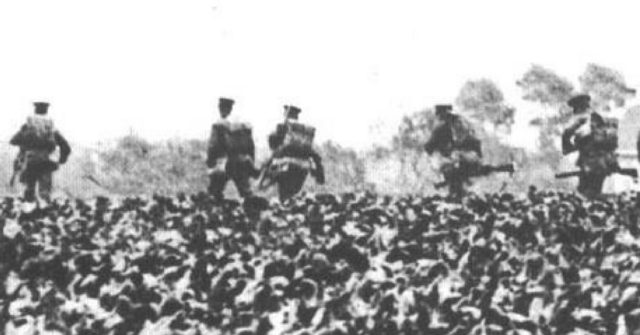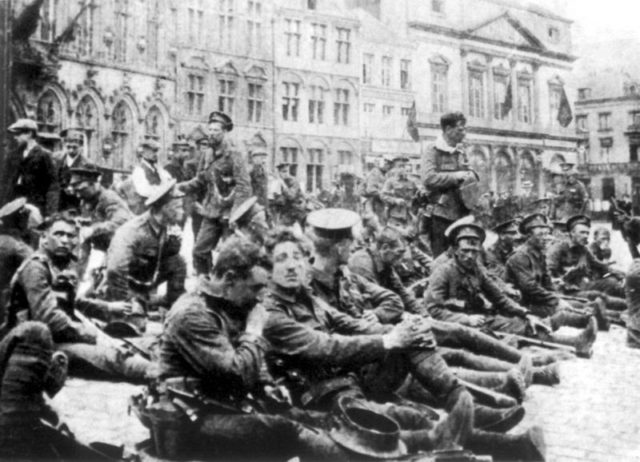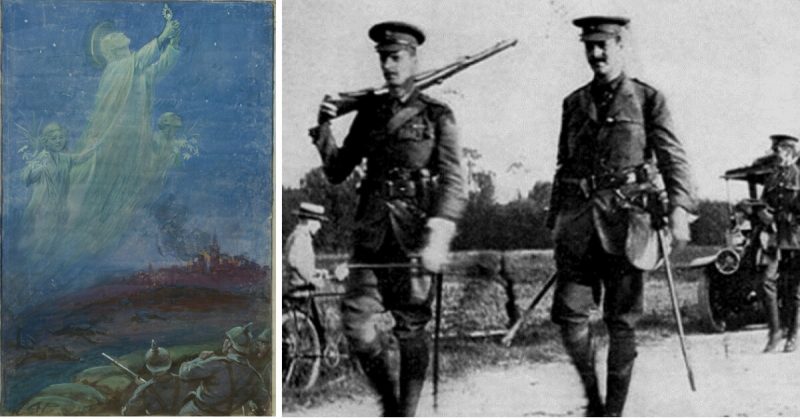On 23rd of August, 1914, the British Expeditionary Force was faced with its first real challenge ― the Battle of Mons. Before the battle, the British were convinced that their military might was untouchable by the German armada, but once the public faced the casualties of the Battle of Mons which lasted less than 24 hours, that perception changed.
The battle was the first defeat of the British Army during WWI, and its impact caused an unpredictable turn of events. At Mons, 1,638 British men lost their lives. For the public, this was a serious blow. In times of peril, legends are made. This is the account of the Angels of Mons, an urban legend which kept the hearts warm back home, while the British were waging a horrific war in France.
It all started when a Welsh author, Arthur Machen, published a short story inspired by the events at Mons, on 29th of September, 1914, more than a month after the battle. The story, titled “The Bowman” was published in the London newspapers, “The Evening News”. It was written as testimony of a soldier, who called St George for help at Mons, and the ghost of a bowman who had fallen at Agincourt in 1415, answered. Even though Machen never intended to create a hoax, the people believed that the events were true, and that the testimony wasn’t fiction, but a retelling of an actual account by a participant of the battle.

Machen’s story echoed with success, as many people became interested in the events he described. One priest asked the writer to give him permission to print the short story in a local parish magazine. The priest, who remains unnamed, wanted to go a step further, and he asked Machen to print the story as a pamphlet in which sources would be included, that would guarantee the credibility of the story.
The writer laughed, and explained that the story was pure fiction and that there were no sources whatsoever. It was a fictional account and a result of an inspiration and patriotic feelings concerning the Battle of Mons.
Anyway, by that time it was already too late. The story started to circulate, and it already had numerous variants, such as the fact that at Mons, German corpses could be found with arrow wounds. The Bowman evolved into an angel. Occultists and experts on ghosts claimed that the creature described by Machen was indeed an angel.
Then, on April 24th, 1915, an obscure magazine called the Spiritualist started printing numerous accounts which claimed that supernatural God-sent beings were appearing on the Western Front, helping the Allies in their struggle.
These widespread rumors raised the people’s moral and helped to convince the British public that their cause was just and that their casualties weren’t in vain. It was an important step in keeping up the war effort, as the homefront was likely to rebel against the war of attrition that was happening in France.
Sermons across Britain claimed that it was an act of divine providence, and both the people and the government accepted that and encouraged it. Soon, newspapers all over the world were writing about angels who help the British soldiers win the day.
Arthur Machen appeared to be the only person against the legend. He published a book on the subject, explaining how exactly he wrote the Bowman story and how it evolved beyond anyone’s imagination. Songs were written on the subject and artists painted pictures that used the angels on the frontline as their motifs. Machen’s effort to discredit the story was seen as treason by some, as it became part of the national mythos and was no longer under his authorship.
The phenomenon grew larger and larger as the media encouraged it more and more. Various hoaxes and false testimonies were made by soldiers on a daily basis, and the public was pleased and proud that God chose to side with the Allied powers. Then finally in 1915, the Society for Psychical Research gave a statement:
“We have received none at all, and of testimony at second-hand we have none that would justify us in assuming the occurrence of any supernormal phenomenon.”
It is important to note that the SPR officially believed in such phenomena but dismissed the notion that any of them happened on the frontlines due to lack of substantial evidence. Some historians debated whether or not this legend was part of a military propaganda operation that saw potential in Machen’s story and decided to exploit it to boost the morale of the people.

Adding to this theory was the fact that one of the main sources of the rumor was Brigadier-General John Charteris. His memoirs, published in 1931, said the story of the Angels of Mons was a popular rumor amongst the troops in September 1914. This makes it the earliest mentioning of the story on the frontline. After examination of his letters from the period it was concluded that Charteris forged the dates in order to once again confirm that the Angels of Mons were actually present during the battle.
Given his association with pieces of allied propaganda like the story of the “German Corpse-Rendering Works” (Kadaververwertungsanstalt) this might indicate Charteris had been behind an attempt to use the Angels for propaganda purposes.
The interest in the subject faded soon after the war, but it was revived in 2001 when an article in The Sunday Times claimed that photographic and film evidence were found that confirmed the existence of the Angels of Mons. Allegedly, a British soldier named William Doidge wrote about the phenomenon in his diary, during his years on the front and even managed to capture the creatures on film.
Immediately, the interest grew once again, as the media started to spread the story worldwide. Marlon Brando and Tony Kaye, two famous actors, insisted on buying this evidence to make a film based on the events. Once it was discovered that the story was a complete hoax, the actors backed out.
Nevertheless, the story of Angels coming to aid remains an example of how easy it is, and how helpful it can be, for people to believe in the supernatural in the most desperate of times.
